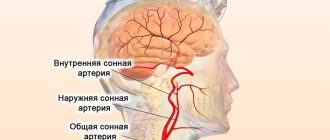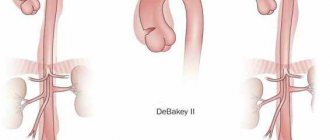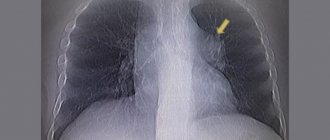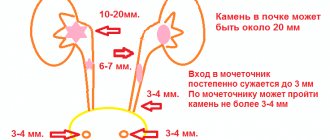Renal artery aneurysms are sac-like bulges in the wall of the renal artery in which blood circulates. According to their structure, renal artery aneurysms are divided into true and false. If true aneurysms consist of all layers of the artery, then false aneurysms are formed due to prolapse of the muscular wall and bulging of only the mucous membrane.
Types of aneurysms and their rupture
Causes
The following diseases and conditions can contribute to the formation of an aneurysm:
- atherosclerosis;
- arterial hypertension;
- congenital defects of the renal artery (for example, with Marfan syndrome);
- penetrating wounds or surgical operations accompanied by arterial injury;
- infections (for example, syphilis) that cause inflammatory processes in the lumen of the vessel;
- bad habits: alcoholism, drug addiction, nicotine addiction;
- elderly age.
Types of aneurysms
It was already mentioned above that, depending on the causes of the occurrence, renal artery aneurysms can be true or false. More often, urologists identify the true forms of such vascular lesions of the artery in question.
How does a protrusion of the renal artery wall form in a true aneurysm? Provoking factors lead to rupture of the inner vascular layer. In this case, other layers of the vascular wall remain intact, but circulating blood enters the lesion and penetrates into the space between the inner and middle layers of the arterial wall. In this way, a so-called pocket is formed, and subsequently the accumulation of blood leads to the formation of a sac-like protrusion.
False aneurysms arise somewhat differently. When such protrusions are formed, only the inner layer undergoes a change in the form of stretching. In this case, the muscle layer of the arterial wall does not change in any way. Such aneurysms are usually caused by traumatic factors: penetrating or gunshot wounds (more often), blunt trauma to the lumbar region or kidneys (less often).
Subsequently, true and false aneurysms increase in size and, depending on their external shape, are divided into the following types:
- Fusiform (or fusiform). Occurs with circular and widespread damage to the vessel wall. A limited area of the vascular wall is subject to stretching and thinning. As a result, the lumen of the vessel expands, and blood flow may be disrupted. It forms vortex-shaped funnels, which further stretches the vascular wall in the affected area.
- Saccular. Such protrusions are formed with local lesions of the vascular walls and are more often observed with false aneurysms. When they form, the inner layer of the artery ruptures and blood enters the cavity. There it forms a clot, to which other portions of condensed blood subsequently “stick”.
Both false and true protrusions of the renal artery can transform into dissecting aneurysms. They can occur when the vascular wall is weak or there is heavy load on the affected vessel.
What you need to know about the disease
More often, this pathology occurs as a complication of other aneuric vascular deformations (abdominal or iliac arteries), but can also be diagnosed as an independent disease.
With an aneurysm of the popliteal artery, dissection of the vascular wall occurs at the level of the popliteal fossa. The artery wall loses its elasticity (splits) at the site of damage and becomes deformed, forming a protrusion and expansion of the vessel. The vascular lumen can increase almost 2 times.
Aneurysms are characterized primarily by a disturbance in the speed of blood flow: at the site of deformation it slows down, often causing stagnation and thrombus formation. Slowing blood flow leads to the fact that the tissues below the site of pathological expansion receive less blood and experience oxygen starvation.
It is customary to distinguish two types of aneurysms:
- true ones, which appear under the influence of unfavorable factors;
- false, arising as a complication of punctures or surgery.
Both types manifest similar symptoms and are equally dangerous for the patient. The distinction between true and false aneurysms is important only for the angiosurgeon when determining treatment tactics.
Symptoms
A renal artery aneurysm, when small in size, is asymptomatic for a long time and can only be detected accidentally during instrumental studies of the renal vessels (for example, Doppler ultrasound, MRI). As the protrusion increases in volume, the patient experiences sensations of fullness and pressing or pulling pain in the lumbar region from the side of the lesion of the renal artery (right or left). Such manifestations are caused by compression of the tissues surrounding the vascular protrusion.
When the ureter is subjected to compression due to the growth of an aneurysm, the patient’s kidney function is severely impaired due to damage to the renal artery. This change leads to the development of renal failure and can result in renal infarction, accompanied by necrosis of the organ. With such changes, the patient develops intoxication syndrome:
- nausea;
- vomit;
- increasing general weakness;
- headache.
Kidney infarction develops faster and more often with saccular aneurysms, since it is with such forms that a greater number of blood clots are present in the lumen of the vessel, causing thrombosis of the artery. In this case, the patient’s symptoms are much more pronounced - more intense pain can radiate to the genitals or groin, the center of the abdominal wall or the thigh. With the development of arterial hypertension, the patient's general health rapidly deteriorates.
Dissecting renal artery aneurysms are rarely detected. When its formation begins, the patient experiences severe and sharp pain in the lumbar region. As the damage to the vessel worsens, the general condition of the patient is sharply and severely disturbed.
The most dangerous consequence of renal artery aneurysms is their rupture with subsequent bleeding. In such cases, the patient develops hemorrhagic shock, which leads to death in 70% of patients.
Signs of a ruptured aneurysm are the following:
- sharp and increasing pain in the side, abdomen or back (increases even with minimal physical activity);
- progressive weakness (up to fainting);
- pronounced pallor of the mucous membranes and skin;
- dyspnea;
- apathy;
- severe headaches;
- tachycardia;
- a sharp decrease in blood pressure.
When such manifestations of aneurysm rupture occur, the patient needs immediate surgical assistance, since any delay in starting the operation greatly increases the patient’s risk of death.
Aneurysm of the lower extremities
28.09.2018
Among the structural pathological changes in our blood vessels , I would like to highlight a disease such as aneurysm . At its core, an aneurysm is a significant enlargement of a vessel in a separate area. Quite often, this pathology affects the vessels of our legs . The femoral and popliteal arteries . It is worth noting that the initial stages of aneurysm are practically asymptomatic, which subsequently negatively affects the treatment of this disease. Any disease responds well to treatment in the early stages of its development, aneurysm is no exception. During its development, accompanied by expansion of the affected area of the vessel , femoral artery aneurysm is manifested by swelling in the groin area, cramps in the legs during physical activity, the appearance of ulcers on the toes , and numbness in certain areas of the legs . If left untreated, the symptoms become pronounced and intensify. Soft tissue necrosis is a common occurrence.
It is worth noting that the manifestation of symptoms is accompanied by pain of varying degrees of severity, sometimes pain is observed even at rest. Severe forms of the disease lead to the development of such irreversible complications as gangrene. It is hardly worth explaining that in this case there is a high risk of death.
The development of popliteal artery aneurysm is often caused by trauma. For most professional athletes, this is a fairly common disease. There is also a false form of the disease, the causes of which are bruises, fractures and unsuccessful surgical interventions. It is worth noting that a false aneurysm of the popliteal artery may be a consequence of a previous infectious disease.
Symptoms of the development of a popliteal artery aneurysm are manifested:
- pain in the knee joint;
- a change in the shade of the skin, the skin becomes bluish in color;
- the temperature of the lower extremities differs significantly from the general body temperature, or, more simply, the legs become cold.
Aneurysm of the popliteal artery can lead to such serious complications as paralysis and complete immobilization of the limb. The most optimal treatment option is surgery , which can stop the progressive disease and prevent irreversible consequences. Among the most severe and often irreversible complications of aneurysms of the femoral and popliteal arteries , it is worth highlighting the development of gangrene as a result of a systematic lack of blood supply; rupture of an artery in the affected area, accompanied by heavy bleeding and hemorrhagic shock; the development of thrombosis arising as a result of atherosclerotic changes in the vessel .
Modern technologies make it possible to carry out treatment using a minimally invasive surgical . The surgeon makes a small incision through which the stent is installed. The rehabilitation period after such an operation is considered short. vascular prosthetics began to be used . Its essence lies in excision of the affected area of the vessel and replacing it with a prosthesis. After the operation, normal blood circulation is restored and the danger of artery . Surgery to remove false aneurysm is fundamentally no different from surgery for a true aneurysm .
Published in Heart and Vascular Diseases Premium Clinic
Possible complications
The most dangerous complication of a renal artery aneurysm can rightfully be considered hypovolemic shock, which develops as a result of the rupture of this vascular protrusion. If the patient loses up to 500 ml of blood, there may be no signs of bleeding at all, but if the patient loses about 2 liters, death occurs.
Another dangerous complication of this vascular defect can be hydronephrosis, accompanied by dilation of the pelvis and degeneration of the kidney parenchyma. This consequence of an aneurysm is observed when the ureter is compressed. In such cases, patients may complain of bursting pain in the lower back and a change in habitual urination. In addition, it is possible that an additional complication of hydronephrosis such as pyelonephritis may occur. In such cases, the patient develops white blood cells (pus) in the urine and has a fever.
With small sizes of renal artery aneurysms, a secondary infection may occur, which leads to inflammation of the retroperitoneal fatty tissue. This consequence is accompanied by fever, lower back pain, and general weakness. Subsequently, the patient may develop sepsis, which often causes the patient’s death.
Danger
Vascular aneurysm is considered an extremely dangerous disease, which, if not treated in a timely manner, can lead to the development of the following complications:
- Due to insufficient blood supply, gangrene develops, which leads to the removal of the limb. If amputation measures are not taken in time, gangrene can lead to infection of the entire body by pathogenic bacteria, which causes death.
- Due to unsuccessful therapeutic measures or puncture sampling, rupture of the artery walls may occur. This complication leads to internal bleeding. If bleeding is not stopped in time, hemorrhagic shock may occur.
- Atherosclerosis can cause thrombosis.
- Surgery performed on a femoral artery aneurysm can provoke myocardial infarction or coronary heart disease.
Diagnostics
The diagnosis of “renal artery aneurysm” can only be confirmed by laboratory and instrumental studies:
- general blood and urine analysis - changes in the results in the form of leukocytosis are detected only with inflammation of the fatty tissue of the retroperitoneal space or rupture of a renal artery aneurysm;
- Doppler ultrasound - a small (usually up to 1 cm in diameter) formation is visualized, pulsating with each heartbeat, and it is the pulsation that distinguishes an aneurysm from malignant or benign tumors;
- angiography - a contrast agent injected into the aorta stains the cavity of the aneurysm, and it becomes visible during an x-ray examination, so the location, size of the protrusion and signs of bleeding from such a vascular formation can be determined;
- CT and MRI angiography - allows for more detailed and accurate visualization and assessment of all data about the aneurysm.
Treatment
If an aneurysm is accidentally detected in the early stages, when the size of the protrusion is very small and there are no symptoms of the disease, the patient is recommended to undergo dynamic monitoring of the hemodynamic picture. To do this, it will be necessary to conduct an ultrasound of the kidneys once a month for a year to determine the size of such a vascular formation.
If during observation signs of aneurysm growth are detected or the patient develops new symptoms indicating a complicated course of the disease, then the patient is prescribed surgical treatment. Previously, such interventions were performed only through open access, that is, after opening the abdominal cavity. During the intervention, the vascular protrusion was ligated and excised. Now such operations are performed less and less thanks to the development of angiography, which allows for minimally invasive intravascular surgical procedures. To carry them out, a catheter is inserted into the lumen of the vessel and the cavity of the aneurysm, through which a special substance is injected to “brick up” the protrusion. In this way, alignment of the lumen of the vessel and normalization of blood flow is achieved.
In addition to this method of eliminating a renal artery aneurysm, the following surgical treatment methods can be performed:
- artery prosthesis - part of the vessel with a protrusion is completely removed and replaced with a prosthesis taken from another part of the patient’s bloodstream;
- clipping – a clip-clamp is applied to the isthmus of the protrusion, preventing the formation of blood clots and normalizing blood flow in the artery;
- turning off the artery and bypassing - is carried out with the aim of completely removing the renal artery and creating a new one using a section of the vessel taken from the patient’s body;
- endovascular strengthening of the aneurysm area with surgical gauze - a minimally invasive intervention consists of applying high-strength material to the protrusion to prevent its progression.
Similar article - How to treat sore knees
When necrosis (infarction) of the kidney develops, a nephrectomy is performed, which involves complete removal of the affected organ.
After the operation, the patient is prescribed a course of antibiotic therapy (broad-spectrum drugs: cephalosporins or penicillins). For patients who have undergone classical types of operations, in addition to drug treatment, physiotherapeutic procedures (UHF, magnetic therapy) are recommended for a faster recovery.
After any of the above-described surgical operations, the patient is advised to undergo a rehabilitation course aimed at preventing possible complications and recovery. Its duration depends on the type of surgery performed.
For example, after endovascular strengthening of the aneurysm area with surgical gauze, the recovery period takes about a week. And when performing prosthetics or bypass surgery – approximately 30 days. During the rehabilitation period, the patient is prescribed a special regime of physical activity, daily routine, nutrition, work and rest.
After removal of a renal artery aneurysm, all patients are advised to follow a gentle diet. The diet may include lean meats, fresh vegetables and fruits (or juices from them), which are necessary for faster recovery. All dishes should be lightly salted, as this food product increases the load on the kidneys. In the first few months after surgery, the drinking regime is reduced to 1 - 1.5 liters of liquid per day (including soups, juices, etc.). The consumption of protein foods and bread should be limited.
Expanding the work and rest regime, physical activity and diet should always be discussed with the doctor during routine outpatient examinations of the patient.
Treatment of renal artery aneurysms
In the absence of clinical symptoms and a stable hemodynamic picture, a wait-and-see approach can be used for a renal artery aneurysm. In this case, an ultrasound examination of the kidneys is performed monthly throughout the year to determine the size of the aneurysm.
If during such a study it is discovered that the aneurysm tends to enlarge or the patient’s general condition is impaired, then there is a need for surgical intervention. Previously, such operations were carried out only in an open manner, when the aneurysm was ligated at the base and excised. Today, such surgical interventions are not performed due to the active development of minimally invasive techniques. Intravascular operations, such as obliteration of renal artery aneurysm, are now actively used. To do this, a special catheter, similar to the one used for angiography, is inserted into the cavity of the aneurysm. After this, a special substance is injected from it, which immediately hardens, “bricking up” the aneurysm.
The advantages of this method are that it is performed under local anesthesia and the patient can easily move around the department the very next day after the operation, and after three days he is completely discharged from the hospital. The only drawback of the operation can be considered its cost, since it costs the patient much more than conventional open surgery.
Which doctor should I contact?
If you experience bursting sensations or pain in the lower back and abdomen, you should consult a urologist. To identify an aneurysm, the patient is prescribed instrumental studies (ultrasound, angiography, CT or MRI angiography), and to exclude possible rupture of a vascular protrusion, pyelonephritis or inflammation of the fatty tissue of the retroperitoneal space, clinical blood and urine tests are performed.
Renal artery aneurysm is a rare pathology, but it is a life-threatening and health-threatening disease that requires mandatory treatment by a doctor. To eliminate it, a surgical operation is required, which, depending on the complexity of the clinical case, can be performed using minimally invasive or classical techniques.
CT angiography for renal artery aneurysm:
It is a pathological expansion of a certain area of the renal vessel, which occurs against the background of weakness of its wall.
Causes
The main reason for the formation of a protrusion is a violation of the structural integrity of the vessel wall. Pathological protrusion may appear in response to the influence of damaging factors. Factors that can provoke the development of an aneurysm include old age, poor nutrition, overeating, bad habits and metabolic disorders caused by diabetes.
The main etiological factors that can cause the appearance of a renal artery aneurysm are
Infectious diseases that trigger the development of mycotic aneurysm. Bacterial damage to the walls of the aorta causes inflammatory and allergic reactions, causing the destruction of elastic fibers in the vessel wall, which increases the likelihood of developing an aneurysm.
Atherosclerosis causes an imbalance in the transfer and utilization of lipoproteins in the systemic circulation, which provokes the development of atherogenesis associated with damage to the vascular intima. In this case, the inner layer of the artery is impregnated with fatty acids, which is accompanied by the occurrence of proliferation, cell destruction and disruption of the transfer of intercellular substances. The influx of leukocytes into the pathological focus can cause inflammation, which is accompanied by a decrease in the elastic strength of the vessel wall.
Congenital diseases associated with intrauterine disruption of the formation of the vascular wall can also cause the development of an aneurysm. Sometimes an aneurysm can occur against the background of hereditary diseases associated with the detection of defects in the muscular layer of the renal arteries. A deficiency of collagen fibers causes weakening of the muscle layer, especially at bifurcations and bends.
Trauma to the renal artery can also in some cases cause the formation of an aneurysmal sac.
Symptoms
If the size of the aneurysmal sac is small, the disease may not manifest itself in any way. In this case, it is detected only during a preventive examination or examination when diagnosing any other disease. An aneurysm that grows in size puts pressure on nearby structures, which is accompanied by a feeling of fullness and nagging pain in the lower back on the affected side.
If the protrusion is located in the kidney, then compression of the ureter is observed, which complicates the functioning of the organ and can cause the development of renal failure or renal infarction.
Such patients experience symptoms of intoxication, nausea, vomiting, weakness, headaches and dizziness. If a saccular form of aneurysm occurs, the risk of developing blood clots with further destruction of kidney tissue increases significantly. With necrosis of the kidney, intense pain in the abdomen appears, radiating to the lower abdomen, genitals or thigh.
Diagnostics
If a renal aortic aneurysm is suspected, the patient may be prescribed X-ray, ultrasound, aortographic and topographic studies, as well as angioscanning.
When examining patients with an aortic aneurysm, fluoroscopy and radiography or ultrasound examination of the genitourinary system are performed. Doppler ultrasound of the renal aorta may be required.
Treatment
With an isolated, small-sized renal aortic aneurysm, expectant management may be required, based on systematic X-ray examination to reduce the likelihood of developing various complications.
Surgical treatment of the disease may be required if a patient has an aneurysm with a size of 0.5 to 1 cm of the aneurysmal sac or an increase in size of the aneurysm by more than 0.5 cm in six months.
If the aorta ruptures, the patient requires emergency surgery.
In all other cases, surgical removal of the aneurysm is performed, based on excision of the aneurysmal sac and replacement of the pathological area with an allograft.
Prevention
Patients at risk for developing an aneurysm should systematically undergo preventive ultrasound examination.
Renal artery aneurysm
- This is a protrusion of the wall of the renal vessel. Can be true or false. Clinically, in the early stages it does not manifest itself in any way, later pain in the lumbar region and symptoms of general intoxication appear, and the functions of the urinary system are disrupted. The pathology can be complicated by necrosis, infectious processes, and internal bleeding. The diagnosis is established on the basis of these instrumental methods: ultrasound, angiography, radiography. Treatment is predominantly surgical with removal of the arterial defect. When massive necrotic or purulent foci form, nephrectomy is indicated.
Symptoms
Manifestations of current artery damage in the kidneys are quite characteristic only at later stages, which makes it possible to timely diagnose their pathological condition and begin the necessary medicinal treatment, preventing the aggravation of the pathological process. However, the early stages do not have pronounced manifestations and changes, which makes diagnosis difficult. This disease is most often diagnosed during a routine examination, for example, an ultrasound of the abdominal cavity.
Manifestations of an aneurysm in the renal artery include changes in the functioning of neighboring organs, which begin to work worse due to the rapid and significant growth of the tumor in the wall of the kidneys. This is expressed as follows:
- when the ureter is compressed, the secretion and excretion of urine deteriorates, which is accompanied by a deterioration in the excretory function of the body. This becomes possible to detect when there is a constant feeling of heaviness in the abdomen and incomplete emptying of the bladder. General weakness, dizziness, and the smell of acetone from the mouth may also be observed;
- blockage of the lumen of the kidney artery with a thrombus, which provokes a significant deterioration in blood circulation in the tissues of the kidneys, up to its complete stop. This is fraught with kidney infarction;
- rupture of an aneurysm, which can occur as a result of the neglect of the pathological condition of the kidneys, is characterized by more obvious and sharp manifestations in the form of a prolonged headache, pronounced pallor of the skin and mucous membranes, pain in the lumbar region, which intensifies with slight exertion.
The listed manifestations characterize more advanced stages of the pathological process in the kidneys, which receive an increased load. In case of any ailment that may be associated with damage to the renal tissues and blood vessels, you should immediately contact a medical facility and undergo a full examination by a kidney doctor (urologist), who will prescribe a suitable drug and therapeutic regimen.
In the most complex or advanced cases, surgical intervention is recommended. This makes it possible to remove the tumor in the thickness of the tissue of the blood vessel in the kidney, which normalizes the process of blood circulation in it.
General information
A renal artery aneurysm is a local dilation of the vessel two or more times its normal diameter. The disease is extremely rare in clinical practice. This is partly explained by the fact that in most patients the pathology is asymptomatic or with scant manifestations, which complicates statistical analysis. The prevalence among all aneurysms is 0.1-0.15%. In 80% of patients, protrusion of the renal artery wall is combined with renal hypertension. No specific patterns were identified between the presence of the disease and the gender or age of patients. In women, the risk of developing an aneurysm increases during pregnancy, when hormonal changes can affect the elastic properties of vessel walls.
Aneurysms of the vessels of the lower extremities - what is it?
Damage to the arteries of the legs is typical for people of working age and the elderly. Among all patients, more than 90% are over 50 years of age. Congenital local dilatations of the vessels of the lower extremities occur in less than 1.2% of cases.
External and internal factors predispose to the disease, including:
- Obliterating endarteritis;
- Syphilis;
- Hypertension;
- Atherosclerosis;
- Acquired defects of the aorta and mitral valve;
- Congenital tortuosity of arteries;
- Pathological communications between large vessels of the legs;
- Injuries;
- Mycosis of the feet.
As a result of a disease or congenital anomaly, true aneurysms develop, which have in their structure all layers of the normal vascular wall. When suffering a trauma (bone fracture, injury, etc.), the expansion is a connective tissue sac connected to the vessel through an additional shunt. Such aneurysms are false. Read more about true and false aneurysms here.
Clinical features:
- Aneurysms of the vessels of the lower extremities are less likely to undergo dissection than those in the aorta or heart (learn about aortic aneurysm dissection here).
- The course of the disease remains hidden in only 2.1% of cases. In the remaining patients, a bright clinic predominates.
- There is a tendency to rapid thrombus formation.
- In 75% of cases, the pathology is combined with an aneurysm in another vascular basin.
- In 28% of cases, simultaneous damage to the abdominal aorta is observed.
At-risk groups:
- Patients with diabetes mellitus and diabetic foot syndrome;
- Patients with trophic disorders of the lower extremities;
- People suffering from osteoporosis and a tendency to fractures.
Causes
The immediate cause of the formation of a protrusion is a violation of the structural integrity of the vascular wall, which occurs in response to the influence of damaging agents. Factors that increase the likelihood of aneurysm formation are considered to be old age, poor diet, bad habits, and metabolic disorders in diabetes mellitus. The main etiofactors for the occurrence of defects are:
- Atherosclerosis.
An imbalance in the transport and utilization of lipoproteins in the systemic circulation leads to atherogenesis with damage to the vascular intima. Fatty acids permeate the inner layer of the artery, causing proliferation, cell death, and transformation of the intercellular substance. The migration of leukocytes to the lesion causes an inflammatory response. Pathological processes taken together cause a decrease in the elastic strength of the wall, especially when atherosclerosis is combined with arterial hypertension. - Infectious diseases.
They trigger the development of a mycotic (secondary infectious) aneurysm. The bacterial process in the vessel wall causes inflammatory and immune responses, which potentiate the dissolution of the elastic structures of the renal artery, increasing the risk of developing aneurysms. The most common infections complicated by vascular protrusions are syphilis, tuberculosis, and suppuration of atherosclerotic plaque. - Congenital pathologies.
An aneurysm may be a consequence of a violation of the intrauterine development of the vascular wall or one of the manifestations of a hereditary disease (Marfan syndrome). In both cases, a defect is detected in the muscular layer of the renal arteries. Insufficient production of collagen fibers weakens the muscle layer, especially in places of bifurcation and bends. - Renal artery injury.
It is usually found in the history of patients with a false aneurysm. Injury occurs when a mechanical factor influences the renal vessels - open, with knife and gunshot wounds, or closed. Separately, invasive medical interventions are distinguished with the introduction of probes, catheters, stands into the lumen of the vessel.
Similar article - What do poisonous snakes look like?
Pathogenesis
The basis of the mechanism of aneurysm development is the loss of elastic properties of the medial layer of the wall of the renal artery, leading to its inability to resist blood pressure. Structural disorders can be congenital (with Marfan syndrome) or acquired (with atherosclerosis, arteritis, infectious diseases). First, the inner layer of the vessel ruptures while maintaining the integrity of the remaining layers. Blood enters the resulting defect, and under its pressure, a longitudinal dissection of the classic saccular shape gradually forms at the site of the local lesion. With diffuse circular damage to the artery, the protrusion has a spindle-shaped shape. In false aneurysms, the area of vessel expansion is formed from connective tissue without the participation of the muscle layer.
Direct disintegration of the aneurysm leads to massive bleeding. Microtears can thrombose, after which a retroperitoneal hematoma is formed, followed by encapsulation. When an infection enters the area of the hematoma, suppuration of the adipose tissue occurs; without medical assistance, there is a high risk of developing sepsis. Compression of the renal pyelocaliceal system by a large protrusion impairs the passage of urine, provokes stagnation, which increases the likelihood of pyelonephritis.
Classification
The division of renal vessel aneurysms into separate types is based on the features of their location, causes, and pathogenesis. Based on localization, protrusions of the renal artery trunk itself and its small branches are distinguished; according to etiology, congenital, atherosclerotic, inflammatory, post-traumatic lesions and aneurysms that arise as a result of medical manipulations are distinguished. The most important from a clinical point of view is the classification according to the structure of the vessel wall in the expansion zone:
- True.
They are more common in the area of the main artery or its middle branches, reaching a diameter of 10 cm. This type of aneurysm is combined with structural changes in the vascular wall, especially against the background of atherosclerosis or congenital anomalies of elastic components. Extrarenal localization is typical. Multiple true aneurysms in a “string of beads” pattern are possible with a low risk of rupture. - False.
They are a complication of blunt or penetrating injuries of the lumbar region, accompanied by injury to the vessels of the kidneys. They are diagnosed immediately after injury or in a short period after it (1-2 days). Another development option is iatrogenic, as a result of medical endovascular manipulations in the lumen of the renal artery.
Classification of the disease
Aneurysm of arteries in the kidneys is divided into the following types:
- false, in which a neoplasm that interferes with the blood circulation process is located in one layer of the artery and affects only its mucous part;
- a true aneurysm, in which a formation in the thickness of the tissue of the artery penetrates all its layers and requires immediate surgical intervention.
The false type of the disease most often occurs with penetrating injury or mechanical damage to the kidney, in which there is a through hole in the artery. In this case, a circulatory disorder occurs, expressed in the form of blood penetration not only into the artery cavity, but also into adjacent tissues, which are gradually saturated with blood. As a result, there is a significant decrease in kidney functionality, although over time the hole becomes thrombosed and blood flow is partially restored.
There is also a division of this disease into one- and two-sided varieties, in which both the main artery and its smaller branches can be damaged. Pathological changes in the walls of small capillaries of the arteries of the kidneys are most often observed in young people under the age of 25.
Symptoms
A small aneurysm occurs for a long time without clinical manifestations. Detection of pathology is possible during a routine examination of the kidneys using instrumental methods or diagnosing other diseases. Gradually, the aneurysm enlarges and begins to put pressure on surrounding organs and tissues. The patient experiences a feeling of fullness and nagging pain in the lower back on the affected side.
When the protrusion is located in the kidney, the ureter is subjected to compression, which significantly impairs the functioning of the organ. This can lead to the development of renal failure and kidney infarction. Clinically, this disorder is manifested by symptoms of intoxication: nausea, vomiting, weakness, headache, dizziness. With a saccular form of aneurysm, the risk of blood clots with subsequent necrosis of the kidney tissue is especially high. The onset of necrosis causes intense pain that radiates to the lower abdomen, genitals, and thigh. The patient's general condition is rapidly deteriorating.
Rupture of a vascular protrusion is considered the most dangerous complication of an aneurysm, leading to shock and death in 70% of cases. Signs of internal bleeding are sharp pain in the lower back and abdomen, aggravated by any physical activity, weakness, pallor of the mucous membranes and skin, dry mouth, shortness of breath, tachycardia, headaches, and a sharp decrease in blood pressure. A patient with such symptoms requires immediate surgical attention.
What worries a patient with an aneurysm?
If the vascular formation is large, the patient may complain of lingering pain in the lower back.
If the aneurysm is small, its presence may not cause any subjective sensations. When the volume of the lesion increases, it can press on the organ tissue and ureters, disrupting the function of the renal tissue. The patient is bothered by a pulling and pressing pain in the lumbar region. Various dysuric symptoms are observed, causing a lot of inconvenience, which forces the patient to consult a doctor. When blood passes through the area of the aneurysm, the blood flow in the vessel slows down, resulting in the formation of blood clots, which cause blockage of the arteries with the development of a heart attack.
Aneurysm rupture is extremely life-threatening for the patient, as heavy blood loss often ends in death. Symptoms of a ruptured vessel:
- loss of consciousness, rapid deterioration;
- a sharp decrease in blood pressure;
- pale skin, with a bluish tint;
- cardiopalmus;
- stabbing pain in the lower back.
Complications
The formation of an aneurysm in an arterial vessel of significant diameter is always considered a life-threatening condition due to possible rupture and the development of massive intracavitary bleeding. A loss of 0.5 liters in the initial stages is practically not manifested clinically; with a loss of 2 liters, hypovolemic shock and death of the patient can occur. With a protrusion size of 8-10 cm, the time interval between these two volumes of blood is calculated in minutes. There is a high risk of developing pyelonephritis, especially in the presence of hydronephrosis. The formation of retroperitoneal hematomas can be complicated by suppuration and the formation of abscesses. The appearance of a zone of turbulent blood flow at the site of protrusion becomes a predisposing factor for thrombus formation. A blood clot can lead to blockage of the renal artery and kidney infarction.
Etiology and pathogenesis of the disease
Peripheral artery aneurysm is much less common than aortic aneurysm. It usually affects the artery that runs under the knee. Less commonly, an aneurysm affects an artery in the thigh, the carotid artery in the neck, and sometimes in the arms. 70% of cases of peripheral artery aneurysms occur in the popliteal and femoral. Of these, 4% occur with symptoms of rupture, which can lead to loss of a limb and death of the patient. Therefore, it is extremely important to recognize the disease as early as possible.
Aneurysm is a complication of pathological deformations of the iliac and abdominal arteries. There is a separation of the wall of the vessel under the knee and its deformation, protrusion up to 1.5 cm. The disrupted structure of the vessel leads to stagnation or slowdown of blood flow in the affected area. This in turn leads to complications and thrombosis. Tissues in the pathological area suffer from a lack of oxygen.
Experts distinguish two types of popliteal aneurysm:
The people were taken aback! Joints will recover in 3 days! Attach...
Few people know, but this is exactly what heals joints in 7 days!
- A true aneurysm appears as an independent disease.
- False aneurysm is a complication after puncture or surgery.
Diagnostics
An aneurysm is detected by urologists-nephrologists and vascular surgeons in the presence of appropriate symptoms, and diagnosed using instrumental methods. When small in size, it can be asymptomatic and detected by chance. Physical and laboratory methods are not very informative in the onset of the disease; they can only indirectly indicate the presence of inflammation or confirm an imbalance in the lipid spectrum. Key diagnostic measures are:
- Physical examination.
At the stage of aneurysm formation, it does not provide significant data; it is possible to detect pain on palpation, a positive Pasternatsky sign. This method plays a key role in the early detection of renal artery rupture with massive cavitary bleeding. Upon examination, pallor of the skin and mucous membranes, acrocyanosis, dry tongue, shortness of breath, lethargy, and a combination of rapid heart rate and low blood pressure are revealed. - Ultrasonography.
Able to visualize the state of the renal vessels, the presence of formations pulsating in time with the heart rhythm. The combination of ultrasound with Doppler sonography makes it possible to differentiate an aneurysm and a tumor of a vessel or perinephric tissue. A neoplasm is indicated by the presence of its own vessels and a denser structure. - X-ray examination.
Urography is often performed with the use of a contrast agent and reveals indirect signs of protrusion of the vascular wall - deformation of the renal pelvis, uneven filling of the cups. Possible uneven contours of the kidney, enlargement of the organ. When necrotic foci form, an altered structure of the parenchyma is visible on x-ray. - Angiography of the renal arteries.
The contrast agent administered with this research method allows you to evaluate the vascular network of the organ, accurately determine the location of the aneurysm, its type, size, and confirm or refute bleeding. Renal angiography makes it possible to clarify the degree of stenosis, the presence of blood clots, and thromboembolism. - Laboratory methods.
They are of great importance in case of internal bleeding. A general blood test reveals anemia - a decrease in the total amount of hemoglobin and peripheral blood red blood cells. Due to the loss of red blood cells, the hematocrit decreases. Changes in the coagulogram are nonspecific.
Treatment of renal artery aneurysm
If pathology is detected in the early stages, when the size of the protrusion does not exceed 0.5-1 cm, and there are no clinical symptoms of the disease, a wait-and-see approach with dynamic observation and monthly ultrasound monitoring is recommended. If during the next appointment the patient shows signs of enlargement of the aneurysm, changes in well-being appear, indicating a worsening of the process, surgical treatment is indicated. The following methods are used:
- Intravascular surgical interventions.
They are a priority in the treatment of local dilations of the renal artery, they can minimize tissue trauma and improve the prognosis. It is possible to perform vessel prosthetics with reconstruction of the wall using an autograft, applying a clip-clamp, and endovascular strengthening of the defect area with high-strength material that prevents the progression of the disease. If it is impossible to restore the normal structure, the artery is “switched off” from the general blood flow, creating new pathways for blood movement (bypass surgery). - Nephrectomy.
An extreme measure used according to strict indications when it is impossible to eliminate the pathology and its complications using minimally invasive methods. It consists of complete removal of the affected kidney using open or mini access. Indications for surgery include kidney infarction, severe purulent processes with massive irreversible damage to the renal parenchyma.
After surgery, a course of antibiotic therapy with broad-spectrum drugs is indicated. Additionally, physiotherapy is prescribed - UHF, magnetic therapy. The duration of the recovery period depends on the volume of the intervention performed; with endovascular operations to strengthen the vascular wall it is about 7 days, after bypass surgery up to 1 month, after nephrectomy - up to 2 months. A gentle diet is recommended, limiting salt to 2 g per day, liquid to 1-1.5 liters, excluding fatty foods.
Prognosis and prevention
If a renal artery aneurysm is detected in a timely manner and surgical intervention is performed correctly, the prognosis is favorable. The risk of relapse depends on the etiology of the process, treatment of diseases that served as triggers for the formation of a vascular defect. Since the most common cause of loss of elastic properties of the vascular wall is atherosclerosis, prevention is aimed at preventing and correcting metabolic disorders. Patients should adhere to a diet low in salt and fat, plenty of vegetables and fruits, and take anti-atherosclerotic drugs.











